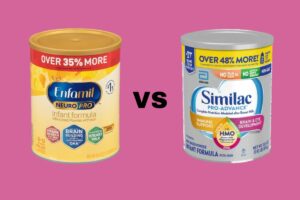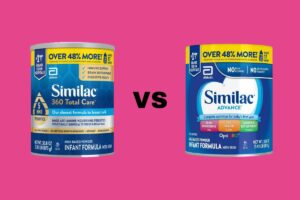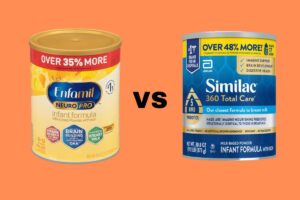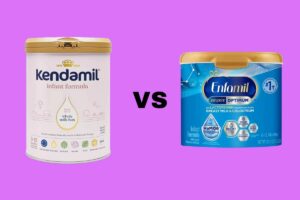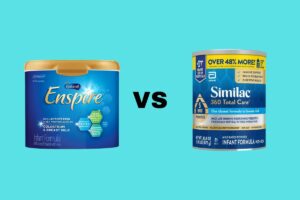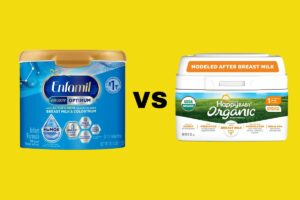
Quick Comparison
| Feature/Aspect | Similac Advance | Similac Pro-Advance |
|---|---|---|
| Purpose | Designed to provide complete nutrition and support baby’s overall development. | Designed to provide complete nutrition while closely mimicking the composition of breast milk. |
| Key Benefits | Supports baby’s immune system and cognitive growth. | Includes 2’-FL HMO for added immune support. |
| Unique Features | Contains OptiGRO™ blend with DHA, lutein, and vitamin E for brain and eye development. Mimics the nutritional profile of breast milk. Contains prebiotics for gut health. | Non-GMO. Contains human milk oligosaccharide (HMO) for immune system support. Contains twice the amount of DHA compared to other Similac products. Includes ARA for brain, nerves, and eyes development. |
| Availability | Mainly in powder form. | Available in both powder and liquid form. |
| Ingredients | Does not contain 2’-FL HMO. Not labeled as non-GMO. | Contains 2’-FL HMO. Labeled as non-GMO. |
| Recommendation | Suitable for parents looking for a formula that mimics the nutritional profile of breast milk. | Suitable for parents looking for a non-GMO option with added immune support. |
Choosing the right infant formula for your baby can be an overwhelming task, with many brands and varieties available to suit different needs.
Similac is a popular formula brand, and two of their well-known options are Similac Advance and Similac Pro-Advance. Both are designed to provide complete nutrition and support your baby’s overall development while being as close to breast milk as possible.
Similac Advance aims to offer a strong foundation for your baby’s immune system and cognitive growth. On the other hand, Similac Pro-Advance takes it a step further with the addition of 2’-FL HMO, an immune-nourishing component found in breast milk. This unique ingredient can help support your baby’s developing immune system even more.
As a parent, it’s essential to weigh factors such as ingredients, nutritional content, price, and potential allergy concerns when choosing between Similac Advance and Pro-Advance.
In this article, we will dive deep into the crucial distinctions between these two formulas and what you need to know to make the best choice for your baby.
Key Takeaways
- Both Similac Advance and Pro-Advance provide complete nutrition for infants, but Pro-Advance includes 2’-FL HMO for added immune support.
- Nutritional comparisons, taste, and baby preference are essential factors to consider when choosing between the two formulas.
- Price differences and safety considerations play a critical role in determining the most suitable option for your baby.
Similac Advance Overview
Similac Advance is a popular infant formula produced by Abbott Laboratories. As a parent, you want to make sure your baby is getting all the necessary nutrients in their early stages of life. Similac Advance could be a great option for you, as it contains essential nutrients to support your baby’s growth and development.
The formula’s key feature is its unique blend, called OptiGRO™. This blend includes important ingredients such as DHA, lutein, and vitamin E, all of which play vital roles in your baby’s brain and eye development. With these ingredients, you can be confident that your little one is receiving the support they need.
Additionally, Similac Advance is designed to mimic the nutritional profile of breast milk, providing a good balance of protein, fats, and carbohydrates. This ensures that your baby’s nutritional needs are met, and they continue to grow healthily. Furthermore, this formula includes a blend of prebiotics that can help promote the growth of good bacteria in your baby’s digestive system, aiding overall gut health.
Finally, it’s essential to be aware that Similac Advance is not a non-GMO product. If you are searching for a non-GMO infant formula, you may want to explore other options, such as Similac Pro Advance. Keep in mind that both formulas have similarities and differences, so it’s important to choose the one that best fits your baby’s needs.
Other Comparisons
Similac Pro Advance Overview
Similac Pro Advance is a popular infant formula designed to provide complete nutrition for your baby while closely mimicking the composition of breast milk. Let’s explore some of its key features, so you can make an informed decision for your little one.
Firstly, you’ll find that Similac Pro Advance is non-GMO, which means that its ingredients have not been genetically modified. Many parents prefer non-GMO options due to various health and environmental concerns.
One of the standout aspects of this formula is the inclusion of a special immune-boosting prebiotic called human milk oligosaccharide (HMO). Although this prebiotic is not derived from human milk, it plays a vital role in supporting your baby’s immune system by promoting healthy gut bacteria. This is a major advantage, as a healthy gut is directly linked to overall health and well-being.
Another beneficial ingredient in Similac Pro Advance is the presence of Omega-3 DHA, which plays a critical role in your baby’s brain and eye development. In fact, Pro Advance has twice the amount of DHA as compared to other Similac products, such as the Total Care formula.
Similac Pro Advance also includes ARA (arachidonic acid), another type of Omega-3 fatty acid that is not found in other products of the Similac brand. ARA is essential for the growth and development of your baby’s brain, nerves, and eyes.
Lastly, you have the option to purchase Similac Pro Advance in both powder or liquid form, adding convenience to your feeding routine. Although Similac Advance also provides complete nutrition and is available in powder form, it rarely offers a liquid formula option.
By taking a closer look at the Similac Pro Advance formula, you can better understand its unique attributes and how they might benefit your baby’s growth and development.
Other Comparisons
Contrasting Ingredients
When comparing Similac Advance and Similac Pro-Advance, it’s important to look at the differences in their ingredients. While both formulas have nearly identical contents and nutritional values, there are a few key distinctions worth noting.
Similac Pro-Advance stands out because it contains 2′-FL HMO, a prebiotic found in breast milk that supports your baby’s immune system. Unfortunately, Similac Advance does not include this immune-boosting ingredient. But regardless of this difference, both formulas are designed to provide your baby with essential nutrients and minerals.
You may also notice that Similac Pro-Advance is labeled as non-GMO, whereas Similac Advance does not have this designation. This means that the ingredients in Similac Pro-Advance are sourced from crops that have not been genetically modified. If you prefer to avoid GMOs in your baby’s diet, Pro-Advance might be a better option.
Another distinction between the two formulas is their availability in different forms. Similac Pro-Advance can be purchased in both powder and liquid form, giving you more flexibility in preparing your baby’s bottles. On the other hand, Similac Advance is primarily available in powder form, with liquid options being rarer.
In summary, while both Similac Advance and Pro-Advance have very similar nutritional profiles, there are some differences in ingredients, such as the presence of the immune-supporting prebiotic 2′-FL HMO in Pro-Advance and its non-GMO status. By understanding these distinctions, you can make an informed decision about which formula is the best fit for your baby’s needs.
Nutritional Comparisons
Vitamins and Minerals
When comparing Similac Advance and Pro Advance, their vitamins and minerals content is quite similar. Both formulas offer a unique OptiGRO blend of essential vitamins and nutrients, with Pro Advance containing a slightly higher amount of DHA (30mg/L) compared to Total Care (25mg/L). While both contain Vitamin A, Total Care offers double the amount compared to Pro Advance.
Prebiotics
Both Similac Advance and Pro Advance contain prebiotic fiber to support the growth of intestinal flora, which is essential for your baby’s developing immune system. However, the key difference lies in the presence of 2′-FL HMO in Pro Advance, an immunity-boosting ingredient found in breast milk.
Probiotics
In this category, there are no significant differences between Similac Advance and Pro Advance. Neither formula contains added probiotics. But you can rest assured knowing that both of these infant formulas still provide essential nutrients for your baby’s growth and development.
Nucleotides
Nucleotides play an essential role in various biological functions, such as cellular replication and metabolism. Both Similac Advance and Pro Advance contain nucleotides as part of their nutrition profile. This is to ensure that your baby receives the necessary building blocks for a healthy development.
In summary, both Similac Advance and Pro Advance provide well-rounded nutrition for your baby, with some minor differences in their vitamin and mineral contents. However, the presence of 2′-FL HMO in Pro Advance remains a critical difference, offering an added layer of immune support for your little one.
Taste and Baby Preference
When choosing between Similac Advance and Pro Advance, you might wonder about the taste and how your baby may prefer one over the other. While babies’ taste preferences can vary, there are some key points to consider.
Similac Advance and Pro Advance are similar in taste and consistency, making it easier to switch between the two if necessary. However, some babies might be more sensitive to differences in taste, texture, or smell. It could take a few tries to identify which formula your baby prefers.
Both Similac Advance and Pro Advance contain the same blend of essential nutrients, but Pro Advance includes an immune-boosting prebiotic, human milk oligosaccharide (not from human milk). This addition does not significantly affect the taste of the formula, but it may contribute to slight variations in flavor that your baby can detect.
Moreover, the Pro Advance version is made with non-r-BST cow milk and avoids genetically engineered ingredients, which might be subtly reflected in the taste. Again, the difference may not be substantial, but it could influence your baby’s overall preference.
To get a better understanding of which formula your baby prefers, you can try offering small amounts of each in separate bottles during a feeding session. Keep track of your baby’s reactions and acceptance of each formula. Remember, it could take a few attempts before your baby gets accustomed to a new formula and truly develops a preference.
In conclusion, there might not be a significant difference in taste between Similac Advance and Pro Advance, but it’s essential to pay attention to your baby’s reactions and preferences. After all, your baby’s comfort and satisfaction are what matters the most for their growth and development.
Price Differences
When considering Similac Advance and Pro Advance for your baby, it’s essential to be aware of their price differences. Since the two formulas have their own unique features and benefits, their costs may also vary.
Similac Advance is a more budget-friendly option compared to Pro Advance. Although it is less expensive, it still contains many essential nutrients that benefit your baby’s growth and development. OptiGRO, Similac’s exclusive blend, is present in both formulas, ensuring high-quality ingredients that support your baby’s health.
On the other hand, Similac Pro Advance may have a higher price point due to its additional features. This formula contains 2’-FL HMO (Human Milk Oligosaccharide), a prebiotic found in breast milk which helps strengthen the baby’s immune system. So, if you’re willing to invest a bit more in your baby’s formula, Pro Advance offers added benefits that you might find valuable.
It’s crucial to keep in mind that prices may change depending on factors like store location, sales, and discounts. To ensure cost-effective choices, be sure to compare prices at different stores and online retailers. Remember, there’s no shame in looking for deals to ease your financial burden.
In conclusion, take the time to assess your financial situation and your baby’s needs when deciding between Similac Advance and Pro Advance. Both formulas offer great options to support your baby’s growth and development, but it’s up to you to determine which one is the best fit for your family.
Packaging and Availability
When choosing between Similac Advance and Pro Advance, it’s essential to look at packaging and availability. Both formulas come in powder and ready-to-feed liquid forms, giving you options based on your preferences and convenience.
Powdered formulas are often more cost-effective and have a longer shelf-life. To prepare, simply mix the required amount of powder with water. On the other hand, ready-to-feed liquid formulas require no mixing, making them an excellent choice for families on-the-go or late-night feedings. Keep in mind that ready-to-feed options tend to be higher in price.
In terms of packaging, the powdered Similac Advance and Pro Advance come in various container sizes such as cans and plastic tubs. These containers are designed with a secure lid to maintain freshness and a built-in scoop for easy measuring. Ready-to-feed liquid formulas are available in bottles and single-use nursette options to ensure that there’s a suitable choice for every family.
As for availability, both Similac Advance and Pro Advance are widely accessible at local grocery stores, pharmacies, and online shopping platforms. However, there may be times when one or the other is in short supply, depending on demand or regional factors.
When comparing the two formulas, remember that the significant differences between them lie in their ingredients – specifically, the addition of 2’-FL HMO in Pro Advance to help support your baby’s immune system. Other than that, packaging and availability are quite similar for both options. Just ensure that you select the right form and package size based on your family’s needs and lifestyle.
Safety Considerations
When choosing between Similac Advance and Pro Advance, it’s crucial to consider the safety aspects of both formulas for your little one. Let’s discuss some key points to help you make the best decision for your baby.
Firstly, both Similac Advance and Pro Advance don’t contain any added sugars or corn syrup and are fortified with iron. They both have OptiGRO, which is Similac’s signature blend of DHA, vitamin E, and lutein. This blend supports your baby’s brain and eye development.
Regarding allergies, Similac Pro Advance may be a better option due to its potentially fewer allergens. This means your baby might be less likely to develop an allergic reaction to the formula. Additionally, Pro Advance offers non-GMO ingredients, which some parents prefer for their infant’s safety as they may want to avoid introducing GMOs to their baby’s diet at such a young age.
In terms of preserving internal organs and not building up antibiotic resistance, Similac Pro Advance seems to be a safer choice, as suggested by some sources. However, to make the most informed decision, consult with your pediatrician and keep updated on the latest research on infant formula.
Lastly, remember that the price of Similac Pro Advance is relatively more expensive compared to Similac Advance, but it offers a nutritionally rich formula that mimics breastmilk as closely as possible. While considering safety, it’s essential to weigh the benefits and potential risks of both formulas and choose what’s best for your baby’s health and your budget.
Remember, always consult your pediatrician and refer to the latest research to understand the safety implications of each formula better.
Allergy Concerns
When choosing between Similac Advance and Pro Advance, it’s important to consider any allergy concerns you may have for your baby. Both formulas have been designed to be gentle on your baby’s digestive system, and they do not contain added sugars or corn syrup. However, there are some differences that may affect your baby’s reaction to each product.
Similac Pro Advance is known for causing fewer allergies when compared to Similac Advance. This is because the Pro Advance formula includes 2′-FL HMO (2′-fucosyllactose), a prebiotic found in breast milk that is known to support the immune system and reduce the risk of allergies. Additionally, Pro Advance does not build up antibiotic resistance, which can contribute to preserving your baby’s internal organs.
While both formulas are fortified with iron and contain Similac’s unique OptiGRO blend, Pro Advance offers a higher amount of carbohydrates, folic acid, and vitamin E compared to Similac Advance. These nutrients provide additional benefits for overall immune support and healthy growth for your baby.
So, as you make your decision between Similac Advance and Pro Advance, take into account the potential allergy concerns, nutrients, and immune support provided by each formula.
While price may also be a factor, keep in mind that Pro Advance can be slightly more expensive due to its added benefits. Ultimately, understanding your baby’s needs and consulting with your healthcare professional can help you choose the best formula for your little one.
Which One Is Better?
When deciding between Similac Advance and Pro Advance, it’s essential to consider their differences and how they might affect your baby’s needs. Both formulas are designed to provide essential nutrients, but there are a few key differences that set them apart.
One of the main distinctions is the presence of 2′-FL HMO in Similac Pro Advance. This prebiotic is the third most abundant component in breast milk and helps support your baby’s immune system. Similac Advance, on the other hand, does not contain 2′-FL HMO.
Another difference to keep in mind is the addition of lutein in both formulas. Lutein is an antioxidant found in breast milk that helps with eye and brain development. While both Advance and Pro Advance contain lutein, the actual amounts may vary. It’s important to remember that a mother’s diet can impact the amount of lutein present in her breast milk.
When it comes to price, you might find that Similac Advance is slightly more affordable than Pro Advance. However, the added benefits of 2′-FL HMO and potentially higher lutein levels in Similac Pro Advance could make it worth the extra cost.
In terms of similarities, both formulas contain essential nutrients like DHA, which is crucial for your baby’s central nervous system development. They also contain prebiotic fiber to help with digestive health. However, it’s worth noting that Similac Total Care, another formula in the Similac family, offers double the Vitamin A compared to Pro Advance and additional immunity ingredients like lactoferrin.
Ultimately, the choice between Similac Advance and Pro Advance depends on your baby’s unique needs and your budget. Both formulas have their advantages, but the presence of 2′-FL HMO and potentially higher lutein levels in Similac Pro Advance might make it a more attractive option for parents seeking a formula that closely mimics the benefits of breast milk.
Summing It Up
When choosing between Similac Advance and Similac Pro Advance, it’s essential to consider your baby’s needs and your preferences. Both options are designed to provide your little one with complete nutrition, aiming to replicate the benefits of breastmilk.
Similac Advance is available at a lower price, making it a budget-friendly choice. On the other hand, Similac Pro Advance tends to be more expensive due to the addition of some essential ingredients. One significant difference between the two is that Similac Pro Advance is non-GMO.
In terms of immune support, Similac Pro Advance has an edge with its prebiotic, called human milk oligosaccharide (not from human milk). This prebiotic makes it more similar to breast milk from an immune-boosting perspective.
For your convenience, you’ll find that Similac Pro Advance comes in both powder and liquid forms. In contrast, Similac Advance is primarily available in powder form, with liquid options being more limited.
Both formulas contain essential nutrients like Omega-3 DHA to support your baby’s brain development. By understanding the similarities and differences between Similac Advance and Pro Advance, you can make an informed decision that best suits your baby’s needs and your preferences. So, go ahead and weigh the pros and cons of each formula to find the perfect fit for your little one.
Frequently Asked Questions
What are the main differences between Similac Advance and Pro Advance?
Similac Advance and Pro Advance both provide nutrition for newborns, but they have a few key differences. Pro Advance contains 2’-FL HMO, a prebiotic found in breast milk that supports the immune system. Similac Advance does not have this ingredient. Additionally, Pro Advance has a slightly different smell, which could be noticeable to some babies.
Which formula is closer to breastmilk, Similac Advance or Pro Advance?
Pro Advance is considered to be closer to breast milk as it contains 2’-FL HMO, a prebiotic found in breastmilk that helps to support the immune system. Both formulas aim to provide nutrition similar to breast milk, but Pro Advance has the added benefit of the HMO prebiotic.
Is Pro Advance better for newborns than Similac Advance?
While both Similac Advance and Pro Advance offer good nutrition for newborns, Pro Advance may have a slight advantage due to the 2′-FL HMO prebiotic, which supports the immune system. However, it’s important to consult with your healthcare professional when choosing a formula for your baby, as individual needs and preferences may vary.
What is the price difference between Similac Pro Advance and Advance?
Price differences may vary by retailer and product size, but in general, Similac Pro Advance tends to be slightly more expensive than Similac Advance. This is mainly due to the addition of the 2′-FL HMO prebiotic in Pro Advance. It is advised to compare prices across various retailers to get the best deal for your chosen product.
Are there any recalls for Similac Advance or Pro Advance?
You should always check the manufacturer’s website and the FDA recall list for the most up-to-date information on product recalls. While no product is immune to recalls, neither Similac Advance nor Pro Advance have had any notable recalls in recent years.
Is there a ready-to-feed option for both Similac Advance and Pro Advance?
Yes, both Similac Advance and Pro Advance offer ready-to-feed options. These options provide a convenient way to feed your baby without the need for mixing and measuring powder. Ready-to-feed formulas can be especially helpful when you’re on the go or need a quick feeding solution.

Carly Link, a 33-year old mother of two toddlers. She is a parent and goes through a lot of the usual parenting difficulties herself. Carly shares all her experiences and knowledge about the best baby products through this blog.
